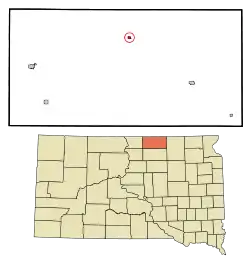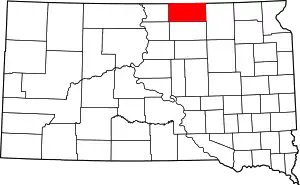Long Lake, South Dakota
Long Lake (Dakota: mdé háŋska;[6] "lake long") is a town in McPherson County, South Dakota, United States. The population was 31 at the 2010 census.
Long Lake
mdé háŋska | |
|---|---|
| Long Lake, South Dakota | |
 Location in McPherson County and the state of South Dakota | |
| Coordinates: 45°51′23″N 99°12′24″W | |
| Country | United States |
| State | South Dakota |
| County | McPherson |
| Incorporated | 1947[1] |
| Area | |
| • Total | 0.28 sq mi (0.72 km2) |
| • Land | 0.28 sq mi (0.72 km2) |
| • Water | 0.00 sq mi (0.00 km2) |
| Elevation | 1,952 ft (595 m) |
| Population | |
| • Total | 31 |
| • Estimate (2019)[4] | 31 |
| • Density | 111.91/sq mi (43.17/km2) |
| Time zone | UTC-6 (Central (CST)) |
| • Summer (DST) | UTC-5 (CDT) |
| ZIP code | 57457 |
| Area code(s) | 605 |
| FIPS code | 46-38860 |
| GNIS feature ID | 1256232[5] |
Geography
Long Lake is located at 45°51′23″N 99°12′24″W (45.856258, -99.206571).[8]
According to the United States Census Bureau, the town has a total area of 0.28 square miles (0.73 km2), all land.[9]
Long Lake has been assigned the ZIP code 57457 and the FIPS place code 38860.
Demographics
| Historical population | |||
|---|---|---|---|
| Census | Pop. | %± | |
| 1950 | 175 | — | |
| 1960 | 109 | −37.7% | |
| 1970 | 128 | 17.4% | |
| 1980 | 117 | −8.6% | |
| 1990 | 64 | −45.3% | |
| 2000 | 58 | −9.4% | |
| 2010 | 31 | −46.6% | |
| 2019 (est.) | 31 | [4] | 0.0% |
| U.S. Decennial Census[10] 2013 Estimate[11] | |||
2010 census
As of the census[3] of 2010, there were 31 people, 18 households, and 9 families residing in the town. The population density was 110.7 inhabitants per square mile (42.7/km2). There were 47 housing units at an average density of 167.9 per square mile (64.8/km2). The racial makeup of the town was 93.5% White and 6.5% Pacific Islander.
There were 18 households, of which 22.2% had children under the age of 18 living with them, 50.0% were married couples living together, and 50.0% were non-families. 50.0% of all households were made up of individuals, and 33.3% had someone living alone who was 65 years of age or older. The average household size was 1.72 and the average family size was 2.44.
The median age in the town was 54.8 years. 12.9% of residents were under the age of 18; 0.0% were between the ages of 18 and 24; 12.9% were from 25 to 44; 38.7% were from 45 to 64; and 35.5% were 65 years of age or older. The gender makeup of the town was 48.4% male and 51.6% female.
2000 census
As of the census of 2000, there were 58 people, 29 households, and 12 families residing in the town. The population density was 210.0 people per square mile (80.0/km2). There were 44 housing units at an average density of 159.3 per square mile (60.7/km2). The racial makeup of the town was 100.00% White.
There were 29 households, out of which 20.7% had children under the age of 18 living with them, 37.9% were married couples living together, 6.9% had a female householder with no husband present, and 55.2% were non-families. 51.7% of all households were made up of individuals, and 34.5% had someone living alone who was 65 years of age or older. The average household size was 2.00 and the average family size was 3.15.
In the town, the population was spread out, with 27.6% under the age of 18, 8.6% from 18 to 24, 10.3% from 25 to 44, 24.1% from 45 to 64, and 29.3% who were 65 years of age or older. The median age was 48 years. For every 100 females, there were 100.0 males. For every 100 females age 18 and over, there were 82.6 males.
The median income for a household in the town was $11,563, and the median income for a family was $16,250. Males had a median income of $16,750 versus $11,250 for females. The per capita income for the town was $8,268. There were 53.8% of families and 60.0% of the population living below the poverty line, including 100.0% of under eighteens and 40.0% of those over 64.
References
- "SD Towns" (PDF). South Dakota State Historical Society. Archived from the original (PDF) on 2010-02-10. Retrieved 2010-02-14.
- "2019 U.S. Gazetteer Files". United States Census Bureau. Retrieved July 30, 2020.
- "U.S. Census website". United States Census Bureau. Retrieved 2012-06-21.
- "Population and Housing Unit Estimates". United States Census Bureau. May 24, 2020. Retrieved May 27, 2020.
- "US Board on Geographic Names". United States Geological Survey. 2007-10-25. Retrieved 2008-01-31.
- Bright, William (2004). Native American Placenames of the United States. Norman, OK: University of Oklahoma Press. p. 255.
- Federal Writers' Project (1940). South Dakota place-names, v.1-3. University of South Dakota. p. 48.
- "US Gazetteer files: 2010, 2000, and 1990". United States Census Bureau. 2011-02-12. Retrieved 2011-04-23.
- "US Gazetteer files 2010". United States Census Bureau. Archived from the original on 2011-02-20. Retrieved 2012-06-21.
- United States Census Bureau. "Census of Population and Housing". Retrieved September 21, 2013.
- "Population Estimates". United States Census Bureau. Archived from the original on 2014-05-22. Retrieved 2014-10-04.
